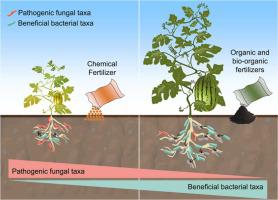Agriculture, Ecosystems & Environment ( IF 6.0 ) Pub Date : 2022-08-13 , DOI: 10.1016/j.agee.2022.108135 Haoqing Zhang , Xianqing Zheng , Xianting Wang , Wu Xiang , Mouliang Xiao , Liang Wei , Yue Zhang , Ke Song , Zheng Zhao , Weiguang Lv , Jianping Chen , Tida Ge

|
The deterioration of the microbiome within the rhizosphere is the main reason behind continuous cropping obstacles and is affected by fertilization regimes. However, the potential associations among fertilization regimes, rhizosphere microbial communities, and the severity of continuous cropping obstacles are poorly understood. Here, we investigated how three-year fertilization regimes (including no fertilizer, chemical fertilizer, organic fertilizer, combination of chemical and organic fertilizer, and bio-organic fertilizer application) affect the rhizosphere microbiome and its associations with continuous cropping growth constraints during the whole growing period of watermelon, using a rhizobox system under greenhouse conditions. The results showed that different fertilization treatments induced drastic shifts in the richness, structure, and composition of rhizosphere microbial communities, whereas the growth stages induced few changes. Compared with no fertilizer treatment, the continuous application of chemical fertilizer inhibited the growth of watermelon. This was strongly associated with the reduced abundance of key ecological clusters within the bacterial co-occurrence network, which contains beneficial bacterial taxa, such as Lysobacter sp. and Haliangium sp. In contrast, continuous application of organic and bio-organic fertilizers promoted the growth of watermelon and was associated with the decreased abundance of key ecological clusters within the fungal co-occurrence network, which contains pathogenic fungal taxa, such as Fusarium sp., Cladosporium sp., and Acremonium sp. Overall, continuous chemical fertilizer application can induce severe continuous cropping obstacles by inhibiting the growth of beneficial bacteria. Continuous application of organic and bio-organic fertilizers can help alleviate such obstacles by suppressing pathogenic fungi. These findings reveal the microbial mechanisms underlying the effects of different fertilization regimes on continuous cropping growth constraints of watermelon.
中文翻译:

施肥方式对西瓜连作生长约束的影响与根际关键生态群的丰度有关
根际微生物组的恶化是连作障碍的主要原因,并受到施肥制度的影响。然而,人们对施肥方式、根际微生物群落和连作障碍严重程度之间的潜在关联知之甚少。在这里,我们调查了三年施肥制度(包括不施肥、化肥、有机肥、化肥和有机肥的结合以及生物有机肥施用)如何影响根际微生物组及其与整个连作生长限制的关系。西瓜生长期,在温室条件下使用 rhizobox 系统。结果表明,不同的施肥处理引起了丰富度、结构、和根际微生物群落的组成,而生长阶段几乎没有变化。与不施肥相比,持续施用化肥抑制了西瓜的生长。这与细菌共现网络中关键生态簇的丰度减少密切相关,其中包含有益的细菌类群,例如溶菌菌属 和Haliangium sp。相反,持续施用有机肥和生物有机肥促进了西瓜的生长,并与真菌共生网络中关键生态簇的丰度降低有关,其中包含致病真菌类群,如镰刀菌属、枝孢菌属。 ., 和顶头孢属植物sp。总体而言,连续施用化肥可通过抑制有益细菌的生长而导致严重的连作障碍。持续施用有机和生物有机肥料可以通过抑制病原真菌来帮助缓解这些障碍。这些发现揭示了不同施肥方案对西瓜连作生长限制影响的微生物机制。











































 京公网安备 11010802027423号
京公网安备 11010802027423号